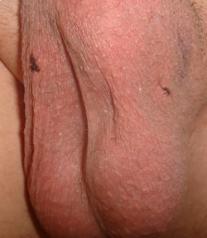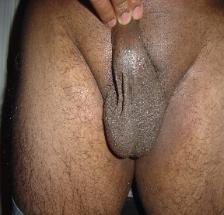Vasectomies
Vasectomy is the most common form of surgical sterilization performed in the United States. Approximately 600,000 vasectomies are performed annually. It is a procedure done to surgically sterilize the male. Once a vasectomy has been successfully completed and the semen has been confirmed to be absent of any sperm, then the couple can enjoy intercourse without the fear of having an unwanted pregnancy. Vasectomy is 99.9% successful.
Vasectomy is usually performed in the doctor's office using a local anesthetic. Only in rare instances will the vasectomy have to be performed in the operating room. Vasectomy is performed through a small opening in the scrotal skin. The skin is anesthetized with a local anesthetic similar to when you have a dental procedure. The vas deferens, the tube carrying sperm from the testicle to the penis, is isolated. The vas deferens is tied usually in two locations and a small segment of the vas deferens is cut out. The small opening in the scrotum is then closed. The entire procedure takes less than 20 minutes.
No-scalpel vasectomy refers to a special technique of vasectomy where the scrotal skin is not cut with a scalpel. Instead, a fine pair of instruments is used to create an opening in the scrotum. The remainder of the procedure is similar to a conventional vasectomy. The advantages of a no-scalpel vasectomy have been reported to be decreased pain at the vasectomy site and decreased chances of bleeding. There is a big psychological advantage to the patient knowing that a scalpel will not be used. Most male reproductive surgeons are well trained to perform this type of procedure.
No-needle vasectomy refers to a technique of performing vasectomy where the local anesthetic is delivered through a jet anesthetic device avoiding the use of a needle. This device delivers the same type of anesthetic that a regular vasectomy receives. The transient discomfort of placing a needle into the scrotal skin is alleviated.
Usually, the recovery after vasectomy is very short. Oftentimes your physician will recommend light activity for 1-3 days after the procedure. Most people are able to return to work the next day, especially if they have a sedentary job. Some people prefer to have the procedure performed on a Friday and rest throughout the weekend.
Most insurance companies will cover the total or partial costs of a vasectomy. It is cheaper for the insurance company to pay for the vasectomy than it is to pay for another pregnancy. Even if your insurance carrier does not cover the costs of a vasectomy, most male reproductive surgeons will perform this procedure for under $1000. Considering the cost to raise a child per year is approximately $10,000, vasectomy is a very affordable option.
There are many different options for male contraception, however, none of them are as reliable as a vasectomy. Unfortunately, a reliable male contraceptive pill is not available. A couple can choose to use condoms. These come in various sizes and sexually transmitted diseases. Condoms can break and they must be applied every time prior to intercourse. Many men report decreased satisfaction during sexual intercourse when they wear a condom. Also, care must be taken not to use a latex condom in couples who have latex allergies. The "withdrawal" method/coitus interruptus or the timing method are other techniques used to prevent pregnancy. These techniques are not reliable and are associated with unacceptable pregnancy rates.
Female contraception includes birth control pills, spermicides, sponges, intra-uterine devices, implantable hormone pellets, and tubal ligation. Birth control pills and implantable hormone pellets are reliable forms of contraception but increase the woman's risk of multiple medical problems such blood clots and cancer. Spermicides and sponges can be irritating to both the male and female partners. Intra-uterine devices can migrate out of position and require a small office procedure to place them by a physician. Tubal ligation is an operation that must be done under general anesthesia and requires abdominal surgery.
Most people who wish to have a vasectomy are sure that they do not want to have any more children in the future. Any doubts about their decision to have a vasectomy can be alleviated by knowing that they have two very important options. The first is to freeze some sperm prior to the vasectomy. This can be arranged by your physician. Sperm can be frozen for many years. The latest successful pregnancy after using frozen sperm is 28 years. The other option is to have a vasectomy reversal. This procedure surgeon. Vasectomy reversal has been successfully accomplished up to 30 years after a vasectomy.
Normally, your physician will require proof that your vasectomy is successful prior to authorizing unprotected intercourse. This is usually determined by demonstrating two semen samples without any sperm. It can take up to 24 ejaculates to clear all of the sperm downstream from the vasectomy site. Your physician will arrange the timing for your semen analysis. It is important to remember that vasectomy does not protect you from sexually transmitted diseases. Other precautions are required in these situations
The following pictures demonstrate the general healing process immediately after the the vasectomy. Dr Karpman uses a No-Scalpel Technique with tiny "keyhole" openings through which the procedure is performed. Typically, maximal swelling is seen 48-72 hours after the procedure and maximal bruising is seen 4-5 days after the procedure.
Day 1
Pictures immediately after vasectomy procedure. Two small openings performed high on the scrotum using a no-scalpel vasectomy technique.


Day 2
Incisions are clean and dry. Minimal swelling, no bruising.


Day 3
Maximal swelling is seen approximately 48 hours after the procedure. Minimal swelling is seen in these pictures. Slight bruising is seen above the left incision on the left photo which is normal.


Day 4
The swelling usually begins to subside at this point. Incisions have two small scabs. Bruising seen over the left incision is not progressing.


Day 5
Swelling has completely subsided. Maximal bruising is usually seen at this point after the vasectomy. The bruising remains small and confined to just above the left incision.


